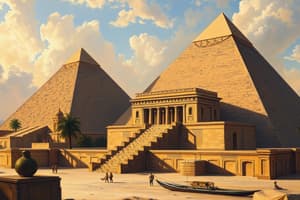Podcast
Questions and Answers
What is the timeframe of the Old Kingdom in Ancient Egypt?
What is the timeframe of the Old Kingdom in Ancient Egypt?
- 3200-3000 BCE
- 3000-2200 BCE (correct)
- 2200-1570 BCE
- 1570-1100 BCE
Which writing material was NOT commonly used by Ancient Egyptians?
Which writing material was NOT commonly used by Ancient Egyptians?
- Wood
- Leather (correct)
- Papyrus
- Stone
What characterized the Middle Kingdom of Ancient Egypt?
What characterized the Middle Kingdom of Ancient Egypt?
- A period of stability and economic growth (correct)
- The construction of the Great Pyramid
- The onset of foreign invasions
- The significant advancements in literature
What was a major focus of Ancient Egyptian religious beliefs?
What was a major focus of Ancient Egyptian religious beliefs?
Which of the following achievements demonstrates Ancient Egypt's advancements in science?
Which of the following achievements demonstrates Ancient Egypt's advancements in science?
What was a primary construction material used in Ancient Egyptian monumental architecture?
What was a primary construction material used in Ancient Egyptian monumental architecture?
What type of literary works were notable in Ancient Egypt?
What type of literary works were notable in Ancient Egypt?
Which period followed the New Kingdom in Ancient Egyptian history?
Which period followed the New Kingdom in Ancient Egyptian history?
Which practice was an important aspect of Ancient Egyptian burial rituals?
Which practice was an important aspect of Ancient Egyptian burial rituals?
Which astronomical advancement did Ancient Egyptians utilize?
Which astronomical advancement did Ancient Egyptians utilize?
Flashcards
Early Dynastic Period
Early Dynastic Period
The period in Ancient Egypt's history that marked the nation's beginnings, lasting approximately from 3200 to 3000 BCE.
Old Kingdom
Old Kingdom
A crucial era in Ancient Egyptian history, spanning from approximately 3000 to 2200 BCE, known for its stable government and impressive architectural achievements.
Middle Kingdom
Middle Kingdom
A period in Ancient Egypt's history from approximately 2200 to 1570 BCE, characterized by relative decline, regional governance, and artistic reinvention.
New Kingdom
New Kingdom
A time of great political and military expansion in Ancient Egypt, lasting from approximately 1570 to 1100 BCE, marked by powerful pharaohs, advanced military strategies, and a rich cultural development.
Signup and view all the flashcards
Late Period
Late Period
The final period in Ancient Egyptian history, spanning from the tenth century BCE to the conquest by Alexander the Great, characterized by political instability and foreign influence.
Signup and view all the flashcards
Pictorial Writing
Pictorial Writing
The original form of Egyptian writing, using pictures to represent words and ideas.
Signup and view all the flashcards
Egyptian Pantheon
Egyptian Pantheon
Ancient Egyptians believed in a vast number of gods and goddesses, each with their own roles and powers, forming a complex religious system.
Signup and view all the flashcards
Mummification
Mummification
The practice of preserving the dead by removing internal organs and wrapping the body in linen strips, aiming to ensure a successful afterlife.
Signup and view all the flashcards
Ancient Egyptian Mathematics
Ancient Egyptian Mathematics
Ancient Egyptians excelled in mathematics, demonstrated by their understanding of basic geometry for land surveying and their development of a numerical system.
Signup and view all the flashcards
Ancient Egyptian Astronomy
Ancient Egyptian Astronomy
Ancient Egyptians possessed advanced knowledge of astronomy, evident in their use of star patterns to create calendars and their understanding of celestial movements.
Signup and view all the flashcardsStudy Notes
Ancient Egyptian Civilization
- Ancient Egyptian civilization emerged in the 4th millennium BCE.
- Key periods of development:
- Early Dynastic Period (circa 3200–3000 BCE)
- Old Kingdom (circa 3000–2200 BCE)
- Middle Kingdom (circa 2200–1570 BCE)
- New Kingdom (circa 1570–1100 BCE)
- Late Period (circa 10th century - 332 BCE)
Key Achievements
-
Writing System: Hieroglyphics evolved from pictorial representations to represent sounds and ideas. Papyrus was a common writing material.
-
Literature: Rich literary traditions included proverbs, hymns, stories, and religious texts. Notable examples include The Story of Sinuhe and The Book of the Dead.
-
Religion and Philosophy: Polytheistic beliefs focused on gods and goddesses associated with natural forces and human activities. Death and the afterlife were significant concepts, leading to elaborate funerary practices.
-
Mathematics and Astronomy: The Egyptians developed mathematical concepts for surveying and construction along with a sophisticated understanding of astronomy, including timekeeping. They determined the annual flooding of the Nile.
-
Medicine: Medical practices, although rudimentary by modern standards, reflected an attempt to understand and treat illnesses. Prescriptions and surgical techniques were developed.
-
Architecture & Engineering:
- Monumental architecture, especially massive pyramids, showcase advanced engineering and construction skills.
- The Great Pyramid of Giza is an iconic example.
- Extensive use of stone and precise geometry were hallmarks of their building projects.
-
Art: Egyptian art style emphasized realism and symbolic representation. Subjects often depicted gods, pharaohs, and everyday life. The style largely remained consistent throughout various periods.
Studying That Suits You
Use AI to generate personalized quizzes and flashcards to suit your learning preferences.




